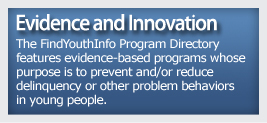References
Alberts, A. E., Chase, P., Naudeau, S., Phelps, E., & Lerner, R. (2006). Qualitative and quantitative assessments of thriving and contribution in early adolescence: Findings from the 4-H study of positive youth development. Journal of Youth Development, 1(2).
Bandy, T., & Moore, K.A. (2009). Non-participation of children and adolescents in out-of-school time programs: Child, family and neighborhood factors. Pub. #2009-39. Washington, D.C.: Child Trends. Retrieved from www.childtrends.org/files/child_trends-2009_07_22_RB_Nonparticipation.pdf (PDF, 6 Pages)
Eccles J. S., & Gootman J. A. (Eds.). (2002). Community programs to promote youth development. Washington, D.C.: National Academy Press.
Gavin, L., Catalano, R., David-Ferdon, C., Gloppen, K., & Markham, C. (2009). A review of positive youth development programs that promote adolescent sexual and reproductive health. Journal of Adolescent Health, 44, S11.
Kegler, M., Young, K., Marshall, L., Bui, D., & Rodine, S. (2005). Positive youth development linked with prevention in a Vietnamese-American community: Successes, challenges, and lessons learned. Journal of Adolescent Health, 37, 69-79.
Kliewer, W., & Murrelle, L. (2007). Risk and protective factors for adolescent substance use: Findings from a study in selected Central American countries. Journal of Adolescent Health, 40, 448-455.
Lerner, R. M. (2004). Liberty: Thriving and civic engagement among America's youth. Thousand Oaks: Sage.
Lerner, R. M., Lerner, J. F., & Phelps, E. (2008). Wave of the future: The first five years of the 4-H study of positive youth development. Institute for Applied Research in Youth Development. Medford, MA: Tufts University.
Pittman, K. (1999). Youth Today: The power of engagement. Forum for Youth Engagement. Retrieved from www.forumforyouthinvestment.org/node/500
Pittman, K., Irby, M., & Ferber, T. (2001). Unfinished business: Further reflections on a decade of promoting youth development. In P.L. Benson and K.J. Pittman (Eds.), Trends in youth development: Visions, realities and challenges. Norwell, MA: Kluwer Academic Publishers.
Roth, J., & Brooks-Gunn, J. (2000). What do adolescents need for healthy development: Implications for youth policy. Social Policy Report 14(1), 3-19.
Wong, K., & Lee, T. (2005). Professional discourse of social workers working with at-risk young people in Hong Kong: Risk or resilience. In M. Ungar (Ed.), Handbook for working with children and youth: Pathways to resilience across cultures and contexts (pp. 313-327). Thousand Oaks, CA: Sage Publications.
Zimmerman, M., & Arunkumar, R. (1994). Resiliency research: Implications for school and policy. Social Policy Report, 8, Ann Arbor, MI: Society for Research on Child Development.
Additional References from Positive Youth Development Literature
America's Promise (2006). Every child, every promise: Turning failure into action. Washington, D.C.: America's Promise. Retrieved from http://www.americaspromise.org/
Benard, B. (1991). Fostering resiliency in kids: Protective factors in the family, school, and community. Portland, OR: Western Center for Drug-Free Schools and Communities.
Benson, P. (1997). All kids are our kids: What communities must do to raise caring and responsible children and adolescents. San Francisco: Jossey-Bass Publishers.
Benson, P. L., Scales, P. C., Hamilton, S. F., & Sesma, A., Jr. (2006). Positive youth development: Theory, research and application.In R. M. Lerner (Ed.), Handbook of child psychology, Vol I: Theoretical models of human development, (pp. 894-941). Hoboken, NJ: Wiley.
Blum, R.W., & Ireland, M. (2004). Reducing risk, increasing protective factors: Findings from the Caribbean Youth Health Survey. Journal of Adolescent Health, 35, 493-500.
Bronfenbrenner, U. (2004). Making human beings human: Bioecological perspectives on human development. Thousand Oaks, CA: Sage.
Bronfenbrenner, U. (1979). The ecology of human development: Experiments by nature and design. Cambridge: Harvard University Press.
Camino, L. (2005). Pitfalls and promising practices of youth-adult partnerships: An evaluator's reflections. Journal of Community Psychology, 33(1), 75-85.
Camino, L. A. (2000). Youth-adult partnerships: Entering new territory in community work and research. Applied Developmental Science, 4, 11-20.
Camino, L., & Zeldin, S. (2002). From periphery to center: Pathways for youth civic engagement in the day-to-day life of communities. Applied Developmental Science, 6(4), 213-220.
Carnegie Corporation of New York (1992). A matter of time: Risk and opportunity in the non- school hours. New York, NY: Carnegie Corporation.
Cargo, M., Grams, G. D., Ottoson, J. M., Ward, P., & Green, L. W. (2003). Empowerment as fostering positive youth development and citizenship. American Journal of Health Behavior, 27, 66-79.
Catalano, R. F., Berglund, M. L., Ryan, J. A. M., Lonczack, H. S., & Hawkins, J. D. (2004). Positive youth development in the United States: Research findings on evaluations of positive youth development programs. Annals of the American Academy of Political and Social Science, 591, 98-124.
Catalano, R. F., Hawkins J. D., Berglund, M. L., Pollard, J. A., & Arthur, M. W. (2002). Prevention science and positive youth development: Competitive or cooperative frameworks? Journal of Adolescent Health, 31(6), 230-239.
Choi, Y., Harachi, T. W., Gillmore, M. R., & Catalano, R. F. (2005). Applicability of the social development model to urban ethnic minority youth: Examining the relationship between external constraints, family socialization, and problem behaviors. Journal of Research on Adolescence, 15(4), 505-534.
Damon, W. (2004). What is positive youth development? Annals of the American Academy of Political and Social Sciences, 591(1), 13-24.
Gambone, M. A., & Connell, J. P. (2004). The community action framework for youth development. The Prevention Researcher, 11(2), 17-20.
Ginsburg, M. T. (2007). Viewing our adolescent patients through a positive lens. Contemporary pediatrics, 24(1), 65-76.
Gressley, K., Tessman, K., Hall, L., & Parrott, A. (August, 2009). Essential elements of the 4-H experience: Overview. Retrieved from http://cals.arizona.edu/pubs/family/az1495.pdf (PDF, 4 Pages).
Flanagan, C. A., & Faison, N. (2001). Youth civic development: Implications of research for social policy and programs. Social Policy Report, 15(1).
Flanagan, C. A., & Van Horn, B. (2003). Youth civic engagement: A logical next step in community youth development. In Villarruel, F. A., Perkins, D. F., Borden, L. M., & Keith, J. G. (Eds.), Community youth development: Programs, policies, and practices (pp. 273- 296). Thousand Oaks, CA: Sage Publications.
Jones, K. R. (2006). Relationships matter: A mixed methods evaluation of youth and adults working together as partners. Journal of Youth Development, 1(2).
Jones, K. R. (2005). Positive youth development. Cooperative Extension Service. Lexington, KY: University of Kentucky.
Jones, K., Byer, K., & Zeldin, S. (2008). Youth-adult partnerships in community decision- making: An evaluation of five state 4-H youth in governance programs. Chevy Chase, MD: National 4-H Council.
Jones, K. R., & Perkins, D. F. (2006). Youth and adult perceptions of their relationships within community-based youth programs. Youth and Society, 38(1), 90-109.
Kress, C. (2004). The eight essential elements of 4-H. Retrieved from http://www.national4-hheadquarters.gov/library/elements.ppt (PowerPoint)
Larson, R. (2000). Toward a psychology of positive youth development. American Psychologist, 55, 170-183.
Leblanc, J. C., Talbot, P. J., & Craig, W. M. (2005). Psychosocial health in youth: An international perspective. In M. Ungar (Ed.), Handbook for working with children and youth: Pathways to resilience across cultures and contexts (pp. 165-188). Thousand Oaks, CA: Sage Publications.
Lerner, R. M., (2005). Promoting positive youth development: Theoretical and empirical bases. Retrieved from http://ase.tufts.edu/iaryd/documents/pubPromotingPositive.pdf (PDF, 92 Pages).
Lerner, R. M. (1995). America's youth in crisis: Challenges and options for programs and policies. Thousand Oaks, CA: Sage.
Lerner, R. M., & Castellino, D. R. (2002). Contemporary developmental theory and adolescence: Developmental systems and applied developmental science. Journal of Adolescent Health, 31, 122-135.
Masten, A. (2001). Ordinary magic: Resilience processes in development. American Psychologist, 56, 227-238.
Pittman K., Irby M., Tolman J., Yohalem N., & Ferber T. (2001). Preventing problems, promoting development, encouraging engagement: Competing priorities or inseparable goals? Forum for Youth Investment. Retrieved from http://www.forumforyouthinvestment.org/node/105
Pollard, J. A., & Hawkins, J. D. (1999). Risk and protection: Are both necessary to understand diverse behavioral outcomes in adolescence? Social Work Research, 23(3), 145-158.
Scales, P. C., & Leffert, N. (1999). Developmental assets: A synthesis of the scientific research on adolescent development. Minneapolis, MN: Search Institute.
Search Institute (1995). Essentials of asset building: A curriculum for trainers – Everyone's an asset builder. Minneapolis, MN: Search Institute.
Sipe, C. L., & Gambone, M. A. (1998). Support for youth: A profile of three communities. Philadelphia, PA: Public Private Ventures.
Tebes, J. K., Feinn, R., Vanderploeg, J. J., Chinman, M. J., Shepard, J., Brabham, T., Genovese, M., & Connell, C. (2007). Impact of a positive youth development program in urban after-school settings on the prevention of adolescent substance use. Journal of Adolescent Health, 41, 239-247.
Tolan, P. H. (1996). How resilient is the concept of resilience? Community psychologist, 29, 12-15.
Villarruel, F. A., Perkins, D. F., Borden, L. M., & Keith, J. G. (2003). Community youth development: Practice, policy and research. Thousand Oaks, CA: Sage.
W.T. Grant Foundation (1988). The forgotten half: Pathways to success for America's youth and young families. New York, NY: W.T. Grant Foundation.
Werner, E. E., & Smith, R. S. (1992). Overcoming the odds: High risk children from birth to adulthood. Ithaca, NY: Cornell University Press.
Youniss, J., McLellan, J. A., & Yates, M. (1997). What we know about engendering civic identity. American Behavioral Scientist, 40, 620-631.
Youth Leadership Institute. (2002). Young active citizens curriculum: Youth and adults at the table. San Francisco, CA: Youth Leadership Institute.
Zeldin, S. (2004). Youth as agents of adult and community development: Mapping the processes and outcomes of youth engaged in organizational governance. Applied Developmental Science, 8, 75-90.
Zeldin, S., Camino, L., Calvert, M., & Ivey, D. (2002). Youth-adult partnerships and positive youth development: Some lessons learned from research and practice in Wisconsin. Madison, WI: University of Wisconsin Extension. Retrieved from http://www1.cyfernet.org/prog/teen/02-youthadult.pdf (PDF, 20 Pages).
Youth Topics
Collaboration Profiles
Briefs
Youth Voices
Feature Articles
Tools & Guides
Programs
Technical Assistance
Websites
Publications
Videos & Podcasts


Announcements

Map My Community is a tool designed specifically to assist you in locating resources in your community to help you build and strengthen your youth program. Get ideas for new partnerships, identify gaps in your community, and learn about resources to avoid duplication of effort.



















